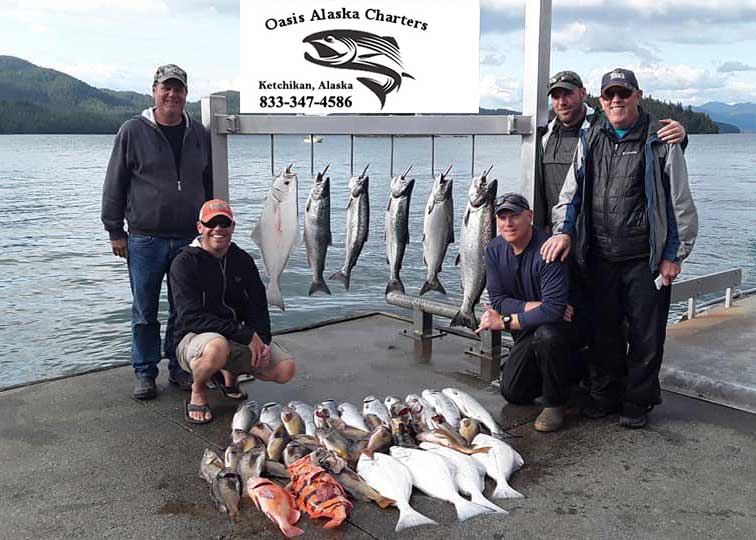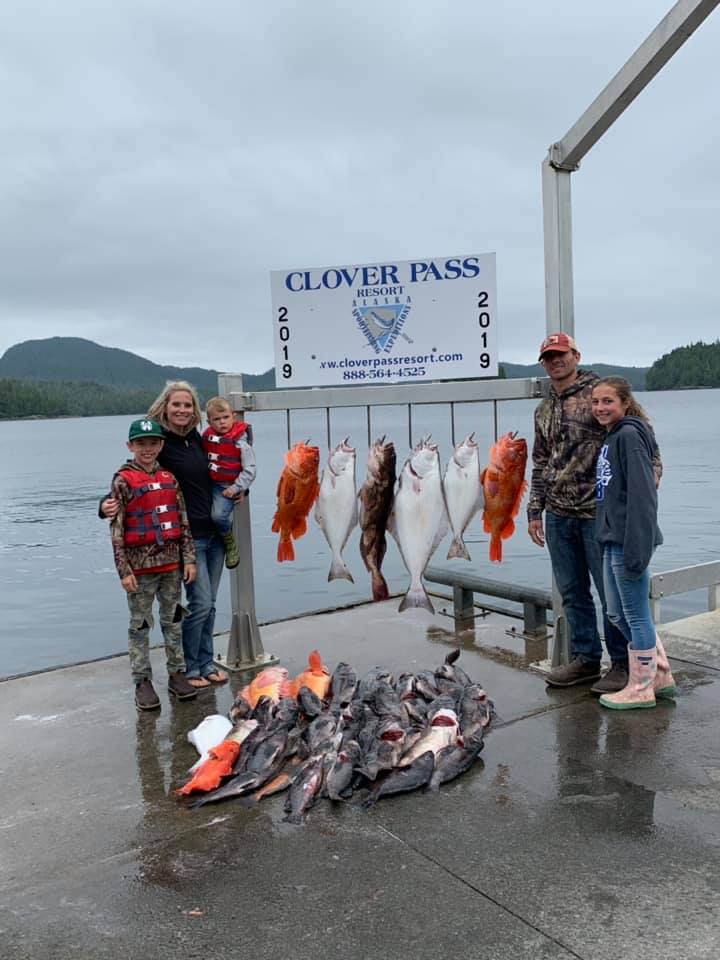[vc_row type=”in_container” full_screen_row_position=”middle” column_margin=”default” scene_position=”center” text_color=”dark” text_align=”left” overlay_strength=”0.3″ shape_divider_position=”bottom” bg_image_animation=”none”][vc_column column_padding=”no-extra-padding” column_padding_position=”all” background_color_opacity=”1″ background_hover_color_opacity=”1″ column_link_target=”_self” column_shadow=”none” column_border_radius=”none” width=”1/1″ tablet_width_inherit=”default” tablet_text_alignment=”default” phone_text_alignment=”default” overlay_strength=”0.3″ column_border_width=”none” column_border_style=”solid” bg_image_animation=”none”][vc_column_text]
Alaska Fishing
Fishing in Alaska is steeped in tradition. This holds true for the first native settlers arriving over 4000 years ago, as well as our modern day frontiersman and women. For all of these generations, one aspect has remained a core part of the lifestyle – The Fishing.
A Complete Visitors Guide
We understand that visiting Alaska for a fishing trip is about something more than the fishing itself. This state has a mystique that triggers your inner most basic instincts as a human, and even though the lifestyle itself may not be in your cards on a permanent level – a fishing vacation here will plug you in to all of those basic desires that will definitely leave a lasting impression.
We think that when you come to fish, this state that you should understand all of the styles, destinations, and species you can fish here. Each of these is draped in an adventure in one form or another. This can include the transit from resort to water to the local shopping center’s to a great place to eat and back, or it can take you to remote locations where you fish for days in lodge style tents along a wild river fully immersed in the state itself.
No matter your dream, we have created this guide to help point you in the right direction to make sure your Alaska dream trip becomes a reality.
Planning Your Alaska Fishing Trip
Planning your Alaska fishing trip or vacation can go beyond the standard itineraries supplied by most. Alaska is packed with professionals that can make every facet of your ideal vacation.
Best Places to Fish in Alaska
This area of the guide is based on what we regard as the absolute best place to fish in the entire state — a plethora of game fish species, resorts, and a nearly year-round fishery.
Alaska Has Something for Everyone
We know the trip to Alaska may mean many different things for everyone in your vacationing party; it can include experiencing the scenery and wildlife to more personal outdoor-related activities such as fishing and hiking. The best thing about adding a fishing trip to your itinerary is that everyone will be able to take away something from the day that meets their vision.
Wildlife viewing while fishing in the state is one of the most popular aspects to consider. Adding the safety of a charter fishing boat, visitors can watch for whales, eagles overhead, or bears on the banks- to name just a few. Or, fly into a remote location and place yourself into the natural surroundings in more of an up-close and personal way.
The experience of fishing here is also deeply tied to both the current and historic native cultures. You will experience a part of the lifestyle that makes your journey here complete. Total immersion in your surroundings, as well as tapping into your inner pioneer!
Did You Know?
No one knows just when the first Eskimos arrived in Alaska, but it was at least 6,000 years ago. The earliest Eskimos inhabited Southwest Alaska. Possibly more Eskimos came to Alaska about 4,500 years ago from coastal Siberia. Although they do not know for sure, archaeologists speculate that the inhabitants of the coast 8,000 years ago might have been Eskimo people.
Planning Your Alaska Fishing Trip
Alaska, the last frontier, the land of the midnight sun, whatever you want to call it, people from all over the world flock to the great state of Alaska for a variety of reasons. Whether those reasons are wildlife viewing, oilfield work, geology study, hiking, or to take in the sights, Alaska is vast and overwhelming and needs to be approached as such. Aside from all the activities mentioned, fishing brings in more people to the state of Alaska than anything else. And with the abundance of fishing, planning your trip ahead of time will help maximize your time on the water.
What type of fishing are you planning on doing? There’s deep water fishing for halibut, lingcod, rockfish, and more, but there are also great places to fish small creeks and rivers for rainbow trout, dolly varden, and more. You also have opportunities to fish remote areas for trophy grayling or hit the world-famous Kenai River for trophy king salmon or to fill your freezer full of that red gold; I’m talking about sockeye salmon. Heck, there’s even ice fishing excursions for trophy northern pike and lake trout if you’re up for enduring the short days and cold weather. So that’s your first step, figuring out what you want to fish for and how. And remember, a lot of the fishing in Alaska is season dependent, especially if you’re going to get in on the salmon runs.
Once you figure out your target species, consider your location within the state that you would like to visit. Most fishing takes place at the coastal or near coastal level since the salmon population are marine species. They need to be able to access the ocean, and of course, that’s where all the deepwater dwellers reside, so be sure to take location very carefully into your consideration. Interior Alaska, however, provides remote streams and rivers for beautiful rainbow trout and lakes for large lake trout and northern pike. You may want to choose an area that provides the best of both worlds, which leads me to my next topic: lodging.
Lodging may be the single most important aspect when planning your Alaskan fishing trip. Lodging not only provides you with a place to sleep, but lodging in Alaska often wraps up fishing packages as well. Some even have their own boats and guides as well as floatplanes to get you to those remote spots up in the hills. Check places like Ketchikan or the Kenai Peninsula, and you may find that remote fishing, deep-sea fishing, and salmon fishing all in one beautifully wrapped package. Some lodges may even clean, seal and store your fish for the duration of your stay and may even cook up your fresh catch for you to enjoy!
Start with these few tips, and your Alaskan fishing trip will sure to be one of the most memorable and tasty experiences ever! FISH ON!
Ketchikan, Alaska is known as the Salmon Capital of the World. It is a fishing town that has picturesque backdrops and a nearly year-round fishery. This area is one of the easiest to get to from the lower 48 and has a resort or place to stay that meets the needs of every traveler type. Fishing in Ketchikan is as much about being a part of this community during your stay, as it is about the fishing itself. Once you get here, it is easy to see why with a vast range of recreational fishing opportunities, several of which are located in secluded wilderness areas, accessible only by boat or small plane.
Alaska Fish Species
Alaska is home to a plethora of fish species. These range from the most popular gamefish and edible species that are considered the most common among visitors. Still, Alaska also has a diverse population of species that range from sharks to feeder fish for the local wildlife. We chose some of the species below to showcase this diversity- some you may have heard of, others you may not know of.
Chinook Salmon
The Chinook salmon is the largest of all Pacific salmon, typically measuring 36 inches in length, often exceeding 30 pounds. Adults are distinguished by the black irregular spotting on the back and dorsal fins and on both lobes of the caudal or tail fin. Chinook salmon also have a black pigment along the gum line.
Chum Salmon
Chum salmon, also known as dog salmon, are the most widely distributed of all the Pacific salmon and generally occur throughout Alaska. Like most other Pacific salmon species, chum salmon spend most of their life feeding in saltwater, then return to freshwater when mature to spawn once in the fall, then die.
Coho Salmon
Adults usually weigh 8 to 12 pounds and are 24 to 30 inches long, but individuals weighing 31 pounds have been landed. Adults in salt water or newly returning to freshwater are bright silver with small black spots on the back and the upper lobe of the tail fin. Unlike Chinook salmon, they lack black pigment.
Pink Salmon
Pink salmon are the smallest of the Pacific salmon found in North America weighing on average between 3.5 and 5 pounds, with an average length of 20-25″. As with all members of the salmon family, pink salmon are coldwater fish. They are also the most numerous and have been harvested and canned in Alaska since the late 1800’s.
Sockeye Salmon
Sockeye salmon is one of the smaller species of Pacific salmon, measuring 18 to 31inches in length and weighing 4-15 pounds. Sea-going sockeye salmon have iridescent silver flanks, a white belly, and a metallic green-blue top, giving them their “blueback” name. Some subtle black speckling may occur on the back.
Pacific Halibut
Pacific halibut is the largest flatfish in Family Pleuronectidae. Halibut and other flatfish are flattened laterally, and swim sideways, with one side facing down and the other facing up. The upper side is typically gray to brown or nearly black, with mottling and numerous spots to blend in with a sandy or muddy bottom.
Black Rockfish
Black rockfish may be distinguished from similar species, such as dark (S. ciliates) and dusky (S. variabilis) rockfish, by the white belly and lack of pores or knob on the lower jaw. Adults may reach a maximum weight of 5 kg (11 lbs) and the maximum length of 69 cm (27.6 in) with females reaching larger sizes than males.
Yelloweye Rockfish
Brilliantly colored from orange-yellow to orange-red, yelloweye rockfish is one of the most well-known and prized of Alaska’s rockfish species. Yelloweye are easily recognized by the bright yellow of their eyes. Individuals have been known to grow up to 36 inches- making them one of the largest of rockfish.
Northern Pike
Northern pike can be variable in color: a fish from a clear stream or lake will usually be light green, while a pike from a dark slough or river will be considerably darker. Males and females are similar in appearance, but females live longer and attain greater size. The state sport fishing record is a 17-kilogram (~38 pounds).
Cutthroat Trout
Coastal cutthroat trout occur as sea-run or freshwater forms in streams and lakes along the coastal range from lower Southeast Alaska to Prince William Sound and are the most common trout in the region. The freshwater form lives in a wide variety of habitats, from small tributaries & bog ponds to large lakes & rivers.
Lake Trout
Lake trout have a body shape similar to that of trout and salmon. They generally have small cream or yellow, irregular shaped spots on a silvery-to-dark background. Males and females are identical, with males having a slightly longer, more pointed snout. Lake trout can be distinguished from other chars by the absence of pink spots.
Steelhead/Rainbow Trout
Since rainbow and steelhead trout are the same species, there are no significant physical differences between them. However, the nature of their differing lifestyles has resulted in subtle variations in color, shape, size, and general appearance. They are indistinguishable as juveniles during the first few years of their life.
Arctic Grayling
The Arctic grayling comes in a wide array of colors. Coloration can vary from stream to stream. Their dorsal fins are typically fringed in red and dotted with large iridescent red, aqua, or purple spots and markings. These colorful markings ( black, silver, gold, or blue) are most dramatic on large grayling.
Lingcod
Lingcod (Ophiodon elongatus) belongs to the family Hexagrammids. Contrary to their name, they are not true cods but are greenlings. Lingcod are voracious predators and can grow to weigh over 80 pounds (35 kg) and measure 60 inches (150 cm) in length. Their color is variable, usually with dark brown or copper.
Sheefish
The Sheefish (inconnu) is the largest member of the whitefish subfamily (family Salmonidae; subfamily Coregoninae). Sheefish are white or silvery in color without spots or other markings and have massive scales. The lower jaw extends beyond the upper jaw, and the mouth is full of small densely-packed teeth.
Dolly Varden
Dolly Varden looks like and is often confused with Arctic char. Dolly Varden generally has a greenish body with many small (smaller than the pupil of the eye) spots, a relatively-thick caudal peduncle (constriction in the body at base of tail fin), and a slightly forked tail. Dolly Varden usually live in streams and rivers.
Burbot
Burbot are frequently referred to as ling or lingcod. Taxonomically, this is incorrect, though. Lingcod are in the family Hexagrammidae (commonly known as the greenling family), whereas burbot is in the Gadidae family (widely known as the cod family). Burbot are the only freshwater cod in North America.
Sablefish
Sablefish are elongated in shape and are dark gray to black on their upper body with a lighter gray underside. They have two dorsal fins that are well separated, which easily distinguish them from skilfish, which have two dorsal fins close together. They are also known as black cod and are a groundfish species.
Salmon Shark
The skin is dusky gray above and paler below with white markings. A strong swimmer, it has a wide tail that has a double keel (a second, short ridge running along the upper part of the lower lobe of the tail). A double keel is unusual among sharks. Salmon sharks can grow to over 10 feet long.
Walleye Pollock
In summer, large aggregations have been found on the east side of Kodiak Island, nearshore along the southern Alaska Peninsula, and other areas. Pollock migrate seasonally between spawning and feeding areas. They feed on copepods, euphausiids, and fish, and are preyed on by other fish, marine mammals, and seabirds.
Want to learn even more about the fishing here?
Take a look at our Alaska Fishing Seasons page where details can be found in regards to what is available in the state all year long.
Offsite References:
Did You Know? area info Alaska History
Information from our site:
[/vc_column_text][/vc_column][/vc_row]


